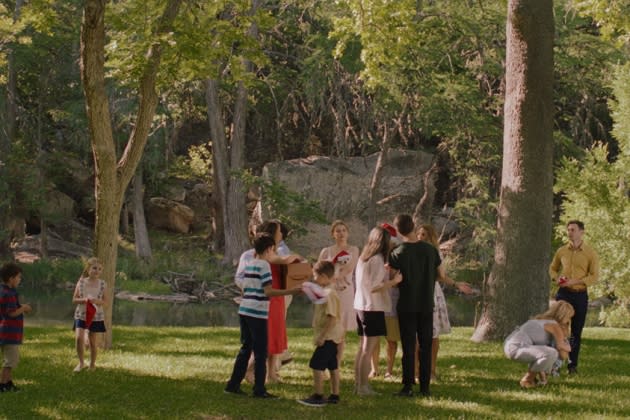‘Family Portrait’ Review: Formally Astute Ensemble Piece Extracts the Unsettling Essence of a Wealthy Clan

Lucy Kerr’s unnerving debut, “Family Portrait,” opens with a sequence where a character is intent on materializing the title in literal fashion. Katy (Deragh Campbell), a 20-something, tries to wrangle adults and children to take a group photo together on a calid afternoon among the greenery in the family’s vast estate. As her relatives walk towards the chosen spot, the camera moves horizontally while bodies come in and out of the frame. Katy, wearing a frustrated expression, struggles to get them to cooperate. Their scattered movement and Katy’s exasperation give the scene a dreamlike uncanniness.
Could these images be Katy’s unconscious preemptively anxious about the task ahead? For the subsequent scenes, Kerr fragments the large group into smaller cohorts settled throughout the property, each having exchanges ranging from the perils of office life to long-established anecdotes. But while free-floating and airy in its construction, the film’s deceiving familiarity slowly erodes, morphing into an unsettling, formally astute brain-tickler observing the placid domesticity of an affluent Texas family in their natural habitat.
More from Variety
'Star Wars' and 'Indiana Jones' Sound Designer Ben Burtt to Be Honored by Locarno Film Festival
'Pulp Fiction' Producer Stacey Sher to Be Honored by Locarno Film Festival
'My Life as a Zucchini' Director Claude Barras to Be Honored by Locarno Film Festival
One scene sees Olek (Chris Galust), Katy’s Polish boyfriend, irate at Americans’ infamous lack of basic world geography knowledge or other countries’ cultures in general, exemplified by her family’s remarks. She explains they are in Texas, as if that should serve as sufficient justification. Their assumption that Oleg must be from Russia or an Eastern European country, rather than the more central Poland, based on his accent says more about the right-leaning ideological spectrum they inhabit than political diatribes could.
Still, more obvious wealth signifiers abound, including their employment of Maria (Vanessa Cedotal), their housekeeper, who presumably works for them wherever they live the rest of the year, and Frank (Ed Hattaway), the handyman in charge of taking care of this vacation home. Other more subcutaneous rules also show their old-money mentality, like the fact that Olek isn’t allowed to be part of the family portrait because he and Katy are still not married. Yet he’s been designated as the photographer to take it. That one of the characters invokes John Carpenter’s “They Live,” a movie where the ruling class turn out to be aliens, lands like a knowing wink both about the characters and the otherworldly atmosphere.
Kerr exhibits a deft control over her visually economical, experimental leaps. She never distorts the image, nor does she use split screens or any other showy editing gimmicks. Cinematographer Lidia Nikonova doesn’t employ disorienting angles or camera moves that call attention to themselves. Instead, the filmmaker relies on a soundscape by sound designers Andrew Siedenburg and Nikolay Antonov and the apathetic, erratic and at times cruel tone of the cast’s performances to place the spectator in an enigmatic daze that feels too close to normalcy for most of the ensemble piece’s short running time.
Something’s off, one can sense it, but whatever it is, Kerr has made it elusive, unnamable. The most explicitly illusory image is that of a hollow tree trunk used as a mystifying hideout, alluding, it seems, to the concept of a family tree or to a passage between dream and reality.
News of a death in the family — no one particularly close but someone they all knew — rattles everyone and prompts Katy’s mother, the person who commissioned the family portrait photo for her elaborate holiday card, to disappear. Suddenly death permeates the air, and conversations shift from small talk to cautionary tales about viruses and illnesses that can take one’s life in an instant. No one cares about this photograph anymore, except for Katy. “Where’s mom?” she will ask to almost anyone who will listen. All of them will ignore her. Campbell’s increasingly flustered, almost catatonic portrayal of Katy illustrates that she and Oleg are not yet fully assimilated into the family’s dynamic. They stand out, not only for their youth, but because they both radiate a desire to please, to be accepted into the club.
Images, especially the still ones, have limitations on what they can elucidate about people and their relationships, since they simply are instances of life frozen without context of what came before or after. Even the moving frame can only so probe so deep beneath the surface. Whatever Olek may have been able to capture in a snapshot would still have resulted in a shiny mask hiding conflicts and fears. The more Katy descends into a hazy loop of disassociation, whether awake or not, the more it seems the prospect of taking the photo is in fact the only thing holding the clan together, and Katy attached to it. Perhaps by not taking it, she can break the cycles that have, so far, endured in this microcosm.
Best of Variety
Sign up for Variety’s Newsletter. For the latest news, follow us on Facebook, Twitter, and Instagram.

 Yahoo News
Yahoo News 